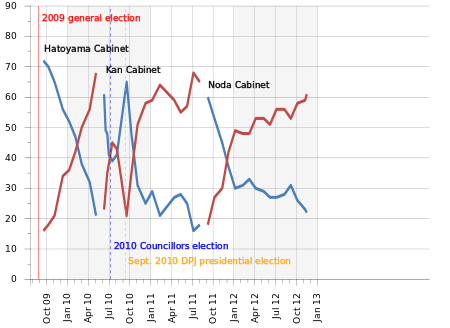
Politics of Japan are conducted in a framework of a dominant-party bicameral parliamentary constitutional monarchy, in which the Emperor is the head of state and the Prime Minister is the head of government and the head of the Cabinet, which directs the executive branch.

The Democratic Party of Japan was a centrist to centre-left liberal or social-liberal political party in Japan from 1998 to 2016.

Naoto Kan is a Japanese politician who served as Prime Minister of Japan and President of the Democratic Party of Japan (DPJ) from June 2010 to September 2011. Kan was the first Prime Minister since the resignation of Junichiro Koizumi in 2006 to serve for more than one year, with his predecessors Yukio Hatoyama, Tarō Asō, Yasuo Fukuda, and Shinzo Abe either resigning prematurely or losing an election. On 26 August 2011, Kan announced his resignation. Yoshihiko Noda was elected as his successor. On 1 August 2012, United Nations Secretary-General Ban Ki-moon announced Kan would be one of the members of the UN high-level panel on the post-2015 development agenda.

Ichirō Ozawa is a Japanese politician and has been a member of the House of Representatives since 1969, representing the Iwate 3rd district. He is often dubbed the "Shadow Shōgun" due to his back-room influence.
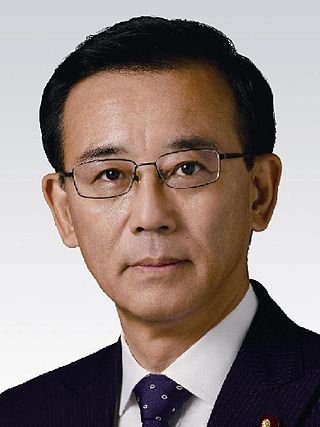
Sadakazu Tanigaki is a Japanese politician who served as a member of the House of Representatives from 1983 to 2016, as Minister of Finance from 2003 to 2006, as President of the Liberal Democratic Party and Leader of the Opposition from 2009 to 2012, as Minister of Justice from 2012 to 2014, and as LDP Secretary-General from 2014 to 2016. He was only the second LDP leader who was not simultaneously Prime Minister of Japan. He retired from politics following a spinal cord injury in 2016 that saw him using a wheelchair.
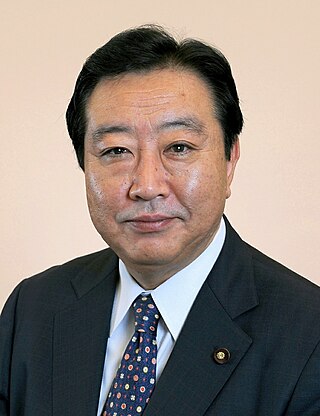
Yoshihiko Noda is a Japanese politician who served as Prime Minister of Japan and Leader of the Democratic Party of Japan from 2011 to 2012. He is a member of the Constitutional Democratic Party of Japan, and a member of the House of Representatives in the Diet. He was named to succeed Naoto Kan as a result of a runoff vote against Banri Kaieda in his party, and was formally appointed by the Emperor Akihito on 2 September 2011.

Goshi Hosono is a Japanese politician and a member of the House of Representatives in the Diet. A native of Ōmihachiman, Shiga and graduate of Kyoto University, he was elected to the House of Representatives for the first time in 2000. He was the Minister of Environment and Minister of State for Nuclear Power Policy and Administration in the cabinet of Yoshihiko Noda. He represents the 5th District of Shizuoka prefecture.
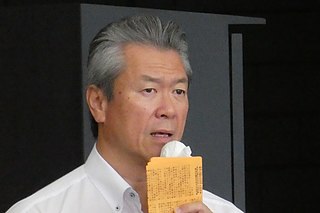
Sumio Mabuchi is a Japanese politician and a member of the House of Representatives in the Diet.

General elections were held in Japan on August 30, 2009 to elect the 480 members of the House of Representatives. The opposition Democratic Party of Japan (DPJ) defeated the ruling coalition in a landslide, winning 221 of the 300 constituency seats and receiving 42.4% of the proportional block votes for another 87 seats, a total of 308 seats to only 119 for the LDP.

Prefectural elections for the Tokyo Metropolitan Assembly were held on 12 July 2009. In the runup to the Japanese general election due by October they were seen as an important test for Taro Aso's ruling coalition of the Liberal Democratic Party (LDP) and the New Komeito. New Komeito considers Tokyo as an important stronghold and had repeatedly asked Prime Minister Aso to avoid holding the two elections within a month of each other.
The Sunrise Party, formerly known as the Sunrise Party of Japan, was a conservative and nationalist political party in Japan. The SPJ was formed on 10 April 2010 by five Japanese lawmakers and parliamentarians, four former members of the Liberal Democratic Party (LDP) and an independent politician. It was named by the then-Tokyo Metropolitan Governor Shintarō Ishihara who supported the action. At its inception, the party described itself as an "anti-DPJ, non-LDP" political force.

The New Renaissance Party was a minor political party in Japan.

Banri Kaieda is a Japanese politician who is serving as the Vice Speaker of the House of Representatives of Japan since 2021. A member of the House of Representatives of Japan, he also served as the President of the Democratic Party of Japan between 2012 and 2014.
Events in the year 2012 in Japan.

House of Councillors elections were held in Japan on July 21, 2013 to elect the members of the upper house of the National Diet. In the previous elections in 2010, the Democratic Party of Japan (DPJ) remained the largest party, but the DPJ-led ruling coalition lost its majority. The House of Councillors is elected by halves to six year terms. In 2013, the class of Councillors elected in 2007 was up.

People's Life First was a short-lived political party in Japan. It had 37 out of the 480 seats in the House of Representatives, and 12 in the 242-member House of Councillors. On 28 November 2012, the party merged into Governor of Shiga Yukiko Kada's Japan Future Party based in Ōtsu.
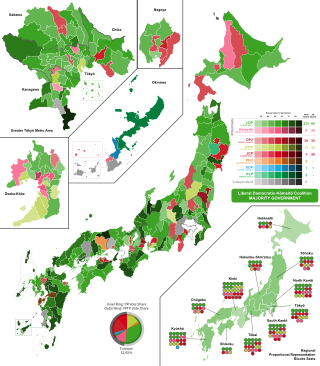
General elections were held in Japan on 14 December 2014. Voting took place in all Representatives constituencies of Japan including proportional blocks to elect the members of the House of Representatives, the lower house of the National Diet of Japan. As the cabinet resigns in the first post-election Diet session after a general House of Representatives election, the lower house election also led to a new election of the prime minister in the Diet, won by incumbent Shinzō Abe, and the appointment of a new cabinet. The voter turnout in this election remains the lowest in Japanese history.

General elections were held in Japan on 22 October 2017. Voting took place in all Representatives constituencies of Japan – 289 single-member districts and eleven proportional blocks – in order to appoint all 465 members of the House of Representatives, the lower house of the then 707-member bicameral National Diet of Japan. Incumbent Prime Minister Shinzō Abe's governing coalition of the Liberal Democratic Party (LDP) and the Komeito party retained their seats in signs of what was perceived as weak opposition. The PM won his fourth term in office and held on to the two-thirds supermajority in order to implement policies on revising the war-renouncing Article 9 of the Japanese Constitution.
The Democratic Party, abbreviated as DP, was a political party in Japan. It was the largest opposition political party in Japan from 2016 until its marginalization in the House of Representatives in 2017. The party was founded on 27 March 2016 from the merger of the Democratic Party of Japan and the Japan Innovation Party. The majority of the party split on 28 September 2017, before the 2017 general election, with many its members contesting the election as candidates for the Party of Hope, Constitutional Democratic Party of Japan or as party members without nomination. On 7 May 2018 the DP merged with the Party of Hope to form the Democratic Party For the People.
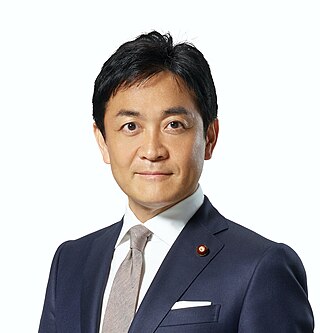
Yuichiro Tamaki is a Japanese politician and the leader of the Democratic Party for the People (DPFP). He is a member of the House of Representatives, and a former leader of Kibō no Tō. Before joining Kibō, Tamaki was a member of the Democratic Party.



